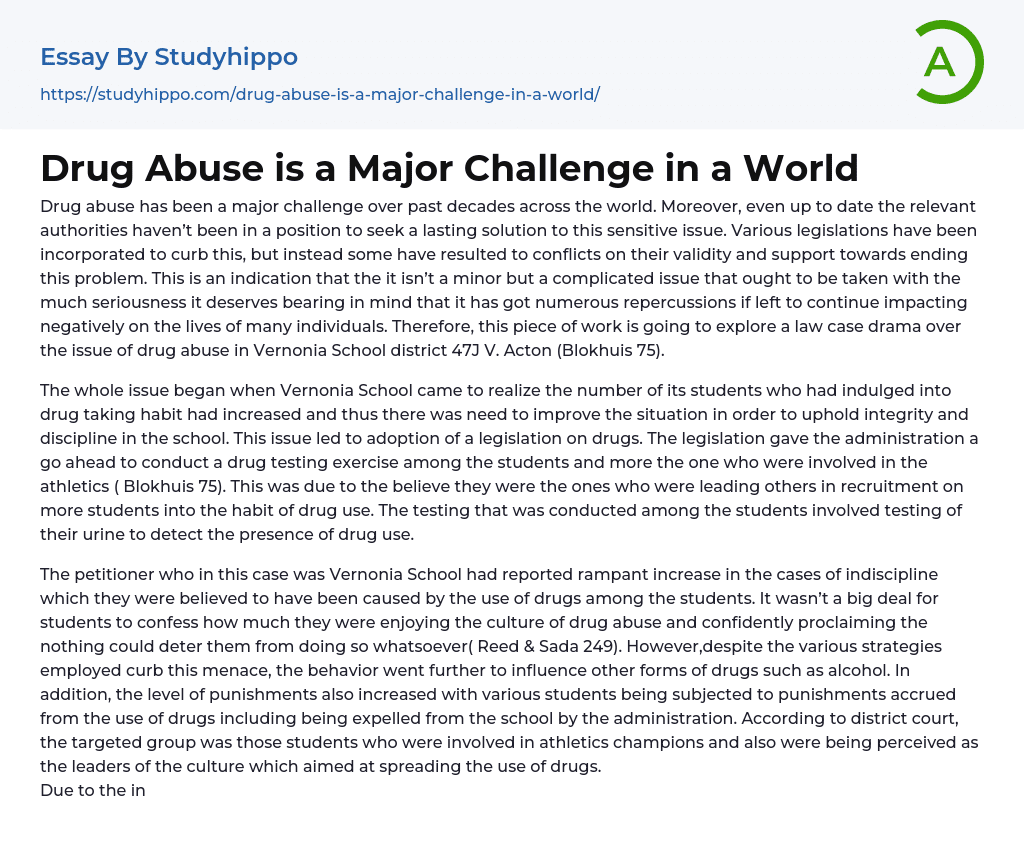Drug abuse has been a long-standing global challenge that remains unresolved. Despite efforts to address this issue through legislation, debates about the effectiveness and support for these measures have arisen. This highlights the complexity of drug abuse and the need to take it seriously. Failure to do so can result in severe negative consequences for individuals' lives.
Consequently, this article will explore a legal case drama concerning drug abuse in Vernonia School District 47J V.
Acton (Blokhuis 75) describes the situation in Vernonia School where the number of students involved in drug use had increased. In order to uphold integrity and discipline, the school administration implemented a legislation on drugs. The legislation authorized the administration to conduct drug tests on students, specifically targeting those involved in athletics (Blokhuis 75). It was believed that these students were the ones infl
...uencing others to engage in drug use. The testing method used was urine analysis to detect the presence of drugs.
The Vernonia School, the petitioner in this case, experienced a notable rise in disciplinary problems attributed to student drug use. Students openly admitted to embracing the drug abuse culture and expressed defiance towards any attempts to prevent it. Despite efforts made to address this issue, drug abuse also started affecting other substances like alcohol. The school responded by increasing punishments for drug use, including potential expulsion. The district court primarily targeted athletes and perceived leaders of the drug culture among students. In light of the escalating number of incidents, the school administration opted to introduce student drug testing.
All students must take a test to participate in sports. The test samples are sent to an independent laboratory to ensure fairness. However,
this policy was challenged when James Acton was denied participation in a football match because he and his parents refused to sign a form allowing him to be drug tested. Athletes were required to undergo a test at the start of the season and could be randomly tested by the administration throughout. Ten players were chosen randomly for each random testing session. Seeking justice, the Acton family filed a lawsuit against the institution. The case reached the U.S. Supreme Court in 1995 (Blokhuis 75).
The court ruling closely examined the extension of the fourteenth amendment, which protects individuals against unreasonable searches and grants them the right to privacy. The supreme court, in a 6-3 vote, favored the school in the case, indicating that the school won while Aton's family lost (Reed & Sada 249). The majority opinion argued that the fourth amendment only covers unauthorized intrusion and does not fully protect an individual's privacy. They also considered the context of the case, where the school employees have some authority to act in place of parents. Thus, the court agreed that the school bears some responsibility for its students' actions as teachers are accountable to parents (Cavanaugh & Michael 86).
The price of the general public exceeded that of the other learners, impacting my education in various ways. This was due to my involvement in an educational center that aligns with my specialization (Blokhuis 75). Through this experience, I gained insight into potential challenges within a learning institution and how to cope with behaviors from fellow learners.
Work Cited
- Reed, Sada. "Four Areas of Collegiate Student-Athlete Privacy Invasion." Communication & Sport 3.3 (2015): 348-363.
- Blokhuis, J. C. "Student Rights and the
Special Characteristics of the School Environment in American Jurisprudence." Journal of Philosophy of Education 49.1 (2015): 65-85.




